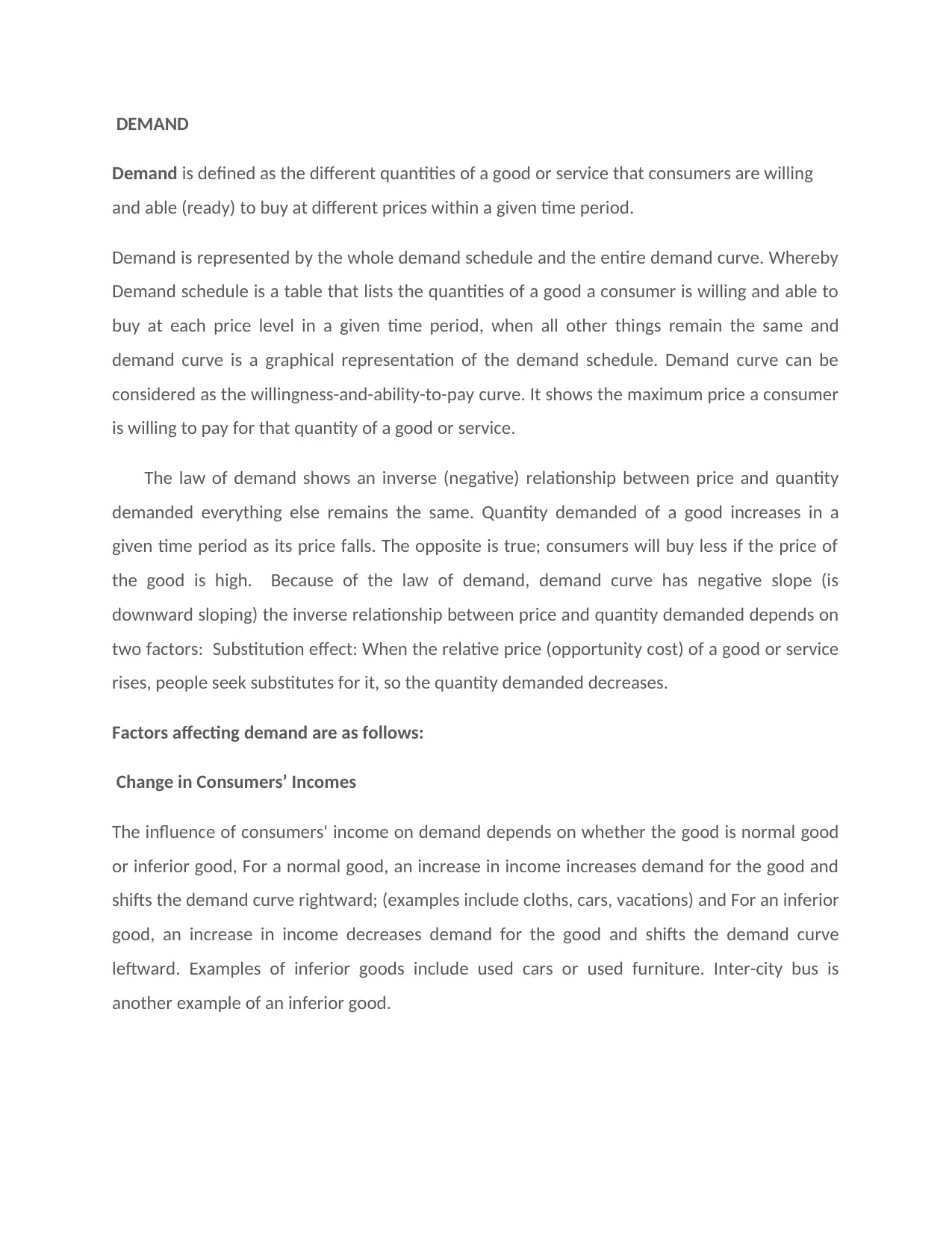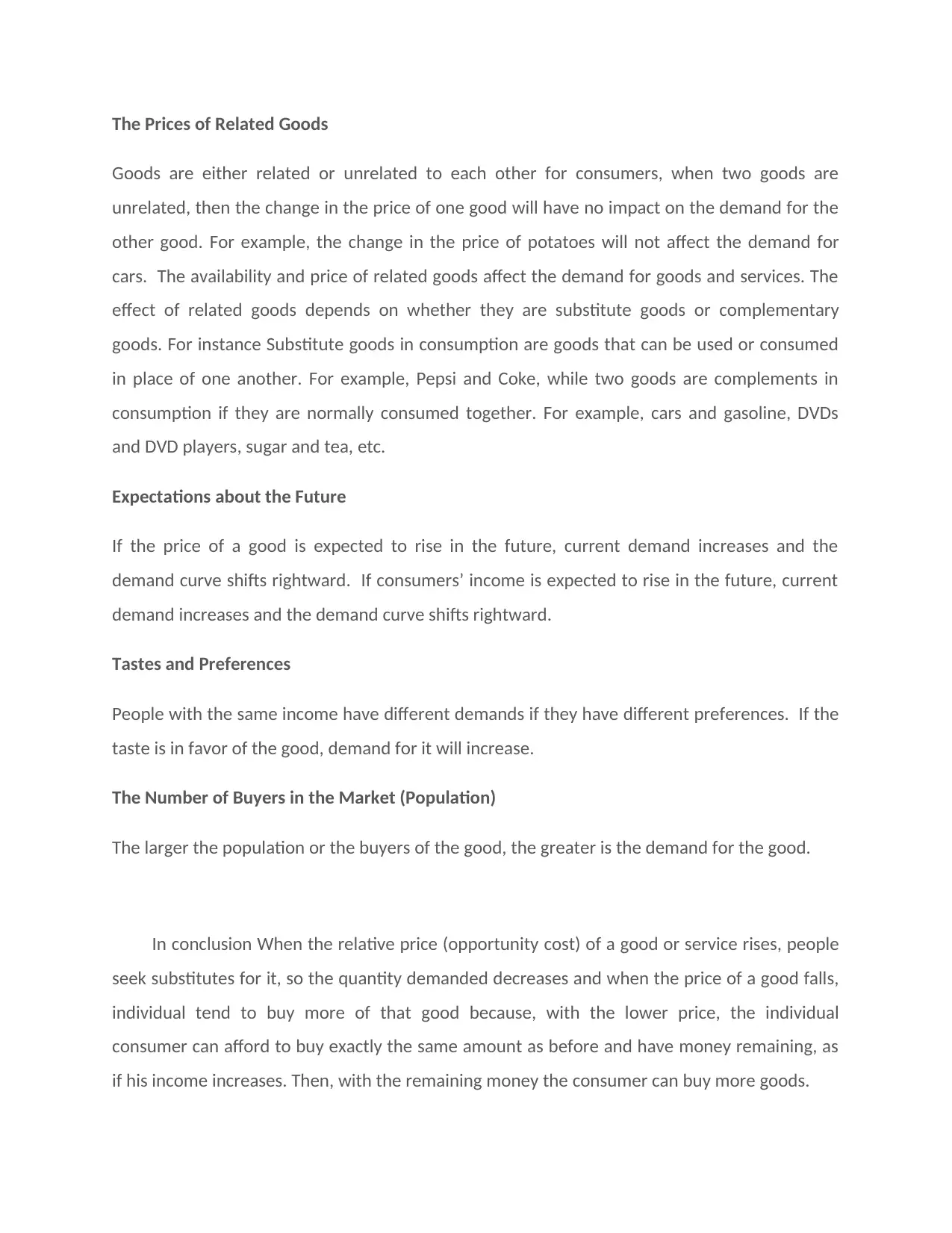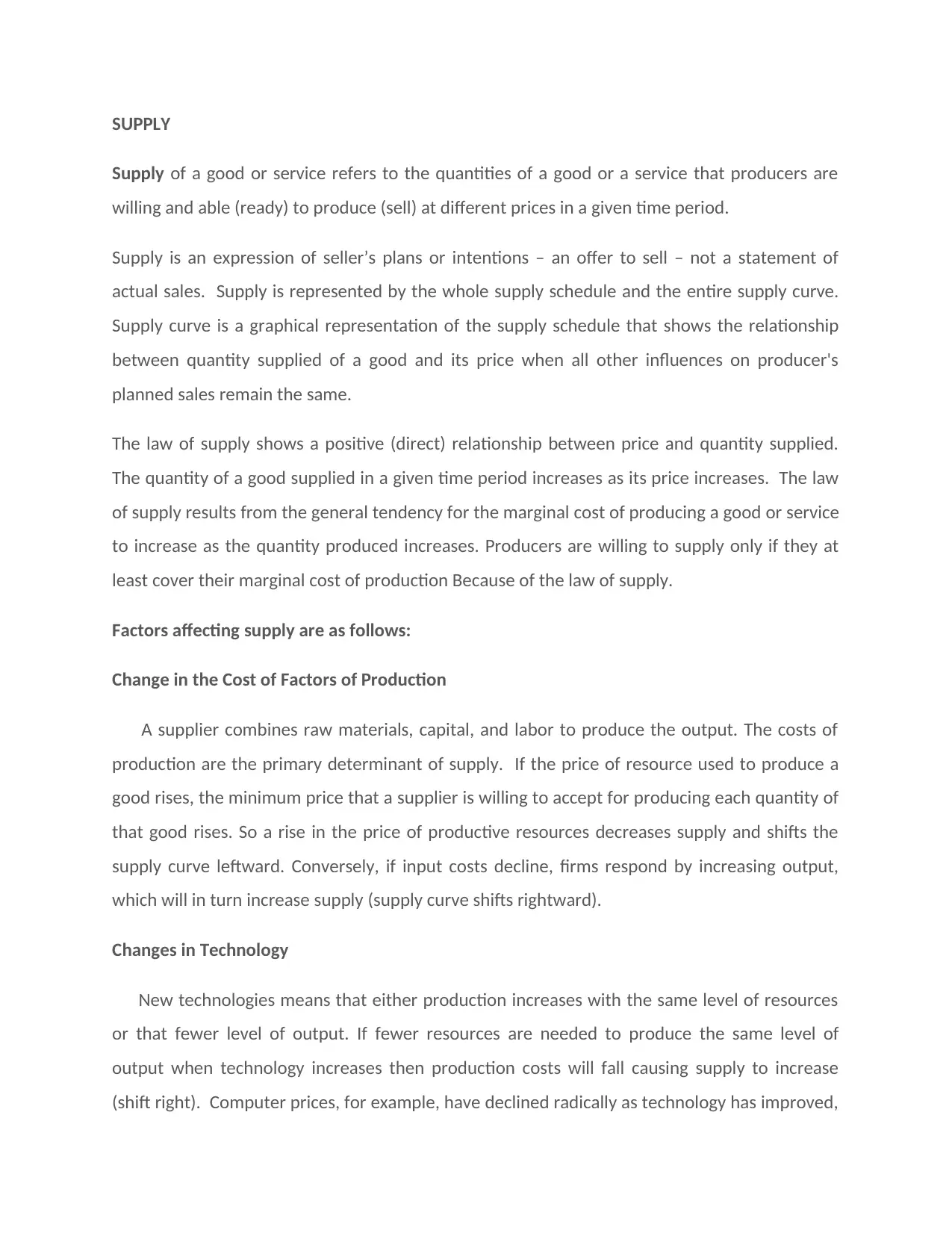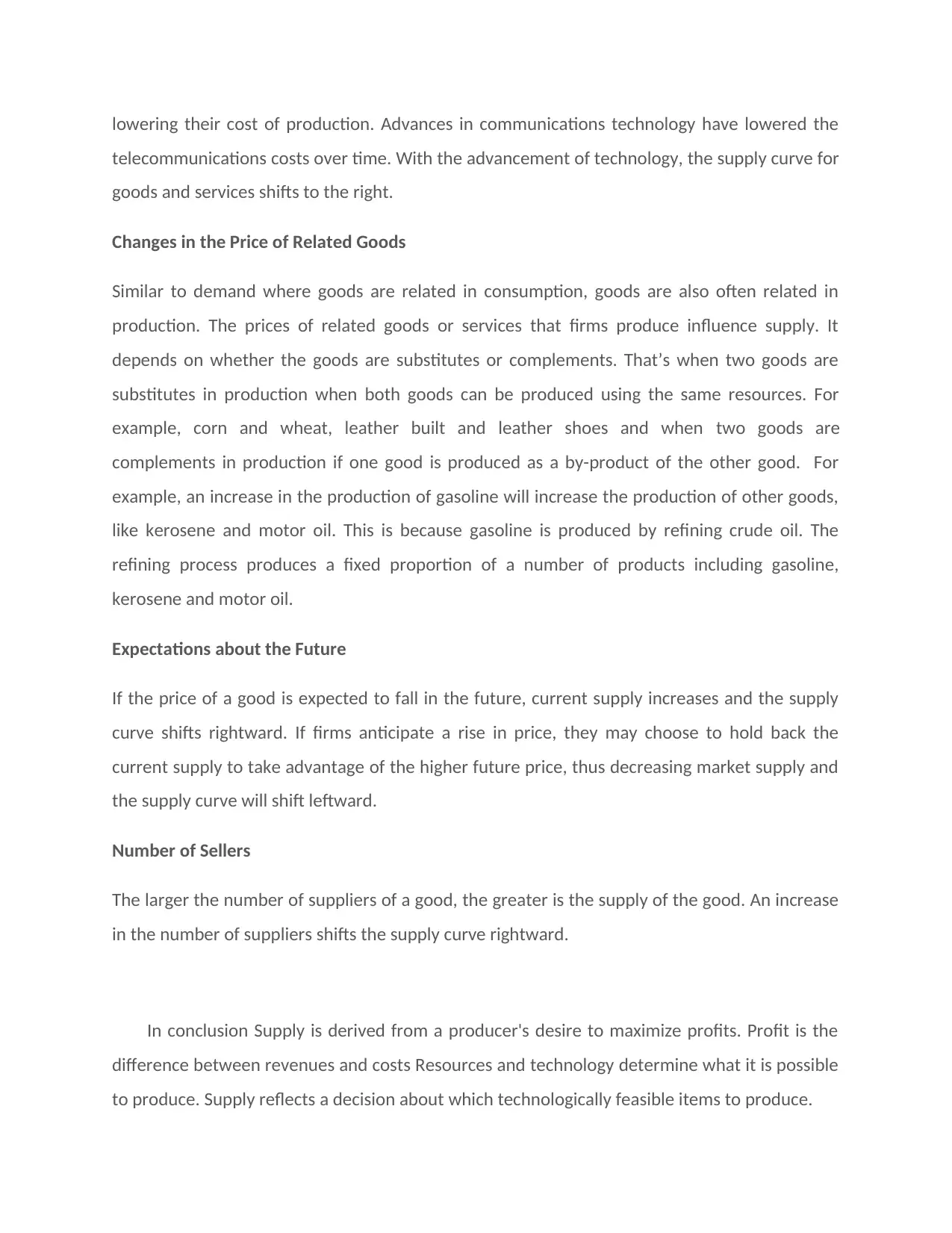Factors Influencing Demand and Supply in Economics: A Study
VerifiedAdded on 2021/05/17
|5
|1468
|163
Homework Assignment
AI Summary
This individual assignment from the Kilimanjaro Institute of Technology and Management, for a Business Administration student, explores the factors affecting demand and supply in economics. The assignment defines demand as the quantity of a good or service consumers are willing and able to buy at different prices, and supply as the quantity producers are willing to offer. The analysis covers the law of demand, substitution effects, and the factors influencing demand such as consumer incomes, prices of related goods (substitutes and complements), expectations, tastes, and the number of buyers. Similarly, it examines the law of supply and the factors influencing supply, including production costs, technology, prices of related goods, expectations, and the number of sellers. The assignment provides a comprehensive overview of how these factors impact market dynamics and price determination.

THE KILIMANJARO INSTITUTE OF TECHNOLOGY AND MANAGEMENT
NAME OF TUTOR: MADAM ERNESTINA
SUBJECT NAME: PRINCIPLES OF ECONOMICS
TASK: INDIVIDUAL ASSIGNMENT
COURSE NAME: BUSINESS ADMINISTRATION
STUDENT NAME: EUNICE OTAIGO
REGISTRATION NUMBER: KITM/0430/DBA/020
QUESTION: Discuss the factors affecting demand and supply
NAME OF TUTOR: MADAM ERNESTINA
SUBJECT NAME: PRINCIPLES OF ECONOMICS
TASK: INDIVIDUAL ASSIGNMENT
COURSE NAME: BUSINESS ADMINISTRATION
STUDENT NAME: EUNICE OTAIGO
REGISTRATION NUMBER: KITM/0430/DBA/020
QUESTION: Discuss the factors affecting demand and supply
Paraphrase This Document
Need a fresh take? Get an instant paraphrase of this document with our AI Paraphraser

DEMAND
Demand is defined as the different quantities of a good or service that consumers are willing
and able (ready) to buy at different prices within a given time period.
Demand is represented by the whole demand schedule and the entire demand curve. Whereby
Demand schedule is a table that lists the quantities of a good a consumer is willing and able to
buy at each price level in a given time period, when all other things remain the same and
demand curve is a graphical representation of the demand schedule. Demand curve can be
considered as the willingness-and-ability-to-pay curve. It shows the maximum price a consumer
is willing to pay for that quantity of a good or service.
The law of demand shows an inverse (negative) relationship between price and quantity
demanded everything else remains the same. Quantity demanded of a good increases in a
given time period as its price falls. The opposite is true; consumers will buy less if the price of
the good is high. Because of the law of demand, demand curve has negative slope (is
downward sloping) the inverse relationship between price and quantity demanded depends on
two factors: Substitution effect: When the relative price (opportunity cost) of a good or service
rises, people seek substitutes for it, so the quantity demanded decreases.
Factors affecting demand are as follows:
Change in Consumers’ Incomes
The influence of consumers' income on demand depends on whether the good is normal good
or inferior good, For a normal good, an increase in income increases demand for the good and
shifts the demand curve rightward; (examples include cloths, cars, vacations) and For an inferior
good, an increase in income decreases demand for the good and shifts the demand curve
leftward. Examples of inferior goods include used cars or used furniture. Inter-city bus is
another example of an inferior good.
Demand is defined as the different quantities of a good or service that consumers are willing
and able (ready) to buy at different prices within a given time period.
Demand is represented by the whole demand schedule and the entire demand curve. Whereby
Demand schedule is a table that lists the quantities of a good a consumer is willing and able to
buy at each price level in a given time period, when all other things remain the same and
demand curve is a graphical representation of the demand schedule. Demand curve can be
considered as the willingness-and-ability-to-pay curve. It shows the maximum price a consumer
is willing to pay for that quantity of a good or service.
The law of demand shows an inverse (negative) relationship between price and quantity
demanded everything else remains the same. Quantity demanded of a good increases in a
given time period as its price falls. The opposite is true; consumers will buy less if the price of
the good is high. Because of the law of demand, demand curve has negative slope (is
downward sloping) the inverse relationship between price and quantity demanded depends on
two factors: Substitution effect: When the relative price (opportunity cost) of a good or service
rises, people seek substitutes for it, so the quantity demanded decreases.
Factors affecting demand are as follows:
Change in Consumers’ Incomes
The influence of consumers' income on demand depends on whether the good is normal good
or inferior good, For a normal good, an increase in income increases demand for the good and
shifts the demand curve rightward; (examples include cloths, cars, vacations) and For an inferior
good, an increase in income decreases demand for the good and shifts the demand curve
leftward. Examples of inferior goods include used cars or used furniture. Inter-city bus is
another example of an inferior good.

The Prices of Related Goods
Goods are either related or unrelated to each other for consumers, when two goods are
unrelated, then the change in the price of one good will have no impact on the demand for the
other good. For example, the change in the price of potatoes will not affect the demand for
cars. The availability and price of related goods affect the demand for goods and services. The
effect of related goods depends on whether they are substitute goods or complementary
goods. For instance Substitute goods in consumption are goods that can be used or consumed
in place of one another. For example, Pepsi and Coke, while two goods are complements in
consumption if they are normally consumed together. For example, cars and gasoline, DVDs
and DVD players, sugar and tea, etc.
Expectations about the Future
If the price of a good is expected to rise in the future, current demand increases and the
demand curve shifts rightward. If consumers’ income is expected to rise in the future, current
demand increases and the demand curve shifts rightward.
Tastes and Preferences
People with the same income have different demands if they have different preferences. If the
taste is in favor of the good, demand for it will increase.
The Number of Buyers in the Market (Population)
The larger the population or the buyers of the good, the greater is the demand for the good.
In conclusion When the relative price (opportunity cost) of a good or service rises, people
seek substitutes for it, so the quantity demanded decreases and when the price of a good falls,
individual tend to buy more of that good because, with the lower price, the individual
consumer can afford to buy exactly the same amount as before and have money remaining, as
if his income increases. Then, with the remaining money the consumer can buy more goods.
Goods are either related or unrelated to each other for consumers, when two goods are
unrelated, then the change in the price of one good will have no impact on the demand for the
other good. For example, the change in the price of potatoes will not affect the demand for
cars. The availability and price of related goods affect the demand for goods and services. The
effect of related goods depends on whether they are substitute goods or complementary
goods. For instance Substitute goods in consumption are goods that can be used or consumed
in place of one another. For example, Pepsi and Coke, while two goods are complements in
consumption if they are normally consumed together. For example, cars and gasoline, DVDs
and DVD players, sugar and tea, etc.
Expectations about the Future
If the price of a good is expected to rise in the future, current demand increases and the
demand curve shifts rightward. If consumers’ income is expected to rise in the future, current
demand increases and the demand curve shifts rightward.
Tastes and Preferences
People with the same income have different demands if they have different preferences. If the
taste is in favor of the good, demand for it will increase.
The Number of Buyers in the Market (Population)
The larger the population or the buyers of the good, the greater is the demand for the good.
In conclusion When the relative price (opportunity cost) of a good or service rises, people
seek substitutes for it, so the quantity demanded decreases and when the price of a good falls,
individual tend to buy more of that good because, with the lower price, the individual
consumer can afford to buy exactly the same amount as before and have money remaining, as
if his income increases. Then, with the remaining money the consumer can buy more goods.
⊘ This is a preview!⊘
Do you want full access?
Subscribe today to unlock all pages.

Trusted by 1+ million students worldwide

SUPPLY
Supply of a good or service refers to the quantities of a good or a service that producers are
willing and able (ready) to produce (sell) at different prices in a given time period.
Supply is an expression of seller’s plans or intentions – an offer to sell – not a statement of
actual sales. Supply is represented by the whole supply schedule and the entire supply curve.
Supply curve is a graphical representation of the supply schedule that shows the relationship
between quantity supplied of a good and its price when all other influences on producer's
planned sales remain the same.
The law of supply shows a positive (direct) relationship between price and quantity supplied.
The quantity of a good supplied in a given time period increases as its price increases. The law
of supply results from the general tendency for the marginal cost of producing a good or service
to increase as the quantity produced increases. Producers are willing to supply only if they at
least cover their marginal cost of production Because of the law of supply.
Factors affecting supply are as follows:
Change in the Cost of Factors of Production
A supplier combines raw materials, capital, and labor to produce the output. The costs of
production are the primary determinant of supply. If the price of resource used to produce a
good rises, the minimum price that a supplier is willing to accept for producing each quantity of
that good rises. So a rise in the price of productive resources decreases supply and shifts the
supply curve leftward. Conversely, if input costs decline, firms respond by increasing output,
which will in turn increase supply (supply curve shifts rightward).
Changes in Technology
New technologies means that either production increases with the same level of resources
or that fewer level of output. If fewer resources are needed to produce the same level of
output when technology increases then production costs will fall causing supply to increase
(shift right). Computer prices, for example, have declined radically as technology has improved,
Supply of a good or service refers to the quantities of a good or a service that producers are
willing and able (ready) to produce (sell) at different prices in a given time period.
Supply is an expression of seller’s plans or intentions – an offer to sell – not a statement of
actual sales. Supply is represented by the whole supply schedule and the entire supply curve.
Supply curve is a graphical representation of the supply schedule that shows the relationship
between quantity supplied of a good and its price when all other influences on producer's
planned sales remain the same.
The law of supply shows a positive (direct) relationship between price and quantity supplied.
The quantity of a good supplied in a given time period increases as its price increases. The law
of supply results from the general tendency for the marginal cost of producing a good or service
to increase as the quantity produced increases. Producers are willing to supply only if they at
least cover their marginal cost of production Because of the law of supply.
Factors affecting supply are as follows:
Change in the Cost of Factors of Production
A supplier combines raw materials, capital, and labor to produce the output. The costs of
production are the primary determinant of supply. If the price of resource used to produce a
good rises, the minimum price that a supplier is willing to accept for producing each quantity of
that good rises. So a rise in the price of productive resources decreases supply and shifts the
supply curve leftward. Conversely, if input costs decline, firms respond by increasing output,
which will in turn increase supply (supply curve shifts rightward).
Changes in Technology
New technologies means that either production increases with the same level of resources
or that fewer level of output. If fewer resources are needed to produce the same level of
output when technology increases then production costs will fall causing supply to increase
(shift right). Computer prices, for example, have declined radically as technology has improved,
Paraphrase This Document
Need a fresh take? Get an instant paraphrase of this document with our AI Paraphraser

lowering their cost of production. Advances in communications technology have lowered the
telecommunications costs over time. With the advancement of technology, the supply curve for
goods and services shifts to the right.
Changes in the Price of Related Goods
Similar to demand where goods are related in consumption, goods are also often related in
production. The prices of related goods or services that firms produce influence supply. It
depends on whether the goods are substitutes or complements. That’s when two goods are
substitutes in production when both goods can be produced using the same resources. For
example, corn and wheat, leather built and leather shoes and when two goods are
complements in production if one good is produced as a by-product of the other good. For
example, an increase in the production of gasoline will increase the production of other goods,
like kerosene and motor oil. This is because gasoline is produced by refining crude oil. The
refining process produces a fixed proportion of a number of products including gasoline,
kerosene and motor oil.
Expectations about the Future
If the price of a good is expected to fall in the future, current supply increases and the supply
curve shifts rightward. If firms anticipate a rise in price, they may choose to hold back the
current supply to take advantage of the higher future price, thus decreasing market supply and
the supply curve will shift leftward.
Number of Sellers
The larger the number of suppliers of a good, the greater is the supply of the good. An increase
in the number of suppliers shifts the supply curve rightward.
In conclusion Supply is derived from a producer's desire to maximize profits. Profit is the
difference between revenues and costs Resources and technology determine what it is possible
to produce. Supply reflects a decision about which technologically feasible items to produce.
telecommunications costs over time. With the advancement of technology, the supply curve for
goods and services shifts to the right.
Changes in the Price of Related Goods
Similar to demand where goods are related in consumption, goods are also often related in
production. The prices of related goods or services that firms produce influence supply. It
depends on whether the goods are substitutes or complements. That’s when two goods are
substitutes in production when both goods can be produced using the same resources. For
example, corn and wheat, leather built and leather shoes and when two goods are
complements in production if one good is produced as a by-product of the other good. For
example, an increase in the production of gasoline will increase the production of other goods,
like kerosene and motor oil. This is because gasoline is produced by refining crude oil. The
refining process produces a fixed proportion of a number of products including gasoline,
kerosene and motor oil.
Expectations about the Future
If the price of a good is expected to fall in the future, current supply increases and the supply
curve shifts rightward. If firms anticipate a rise in price, they may choose to hold back the
current supply to take advantage of the higher future price, thus decreasing market supply and
the supply curve will shift leftward.
Number of Sellers
The larger the number of suppliers of a good, the greater is the supply of the good. An increase
in the number of suppliers shifts the supply curve rightward.
In conclusion Supply is derived from a producer's desire to maximize profits. Profit is the
difference between revenues and costs Resources and technology determine what it is possible
to produce. Supply reflects a decision about which technologically feasible items to produce.
1 out of 5
Related Documents
Your All-in-One AI-Powered Toolkit for Academic Success.
+13062052269
info@desklib.com
Available 24*7 on WhatsApp / Email
![[object Object]](/_next/static/media/star-bottom.7253800d.svg)
Unlock your academic potential
Copyright © 2020–2025 A2Z Services. All Rights Reserved. Developed and managed by ZUCOL.





